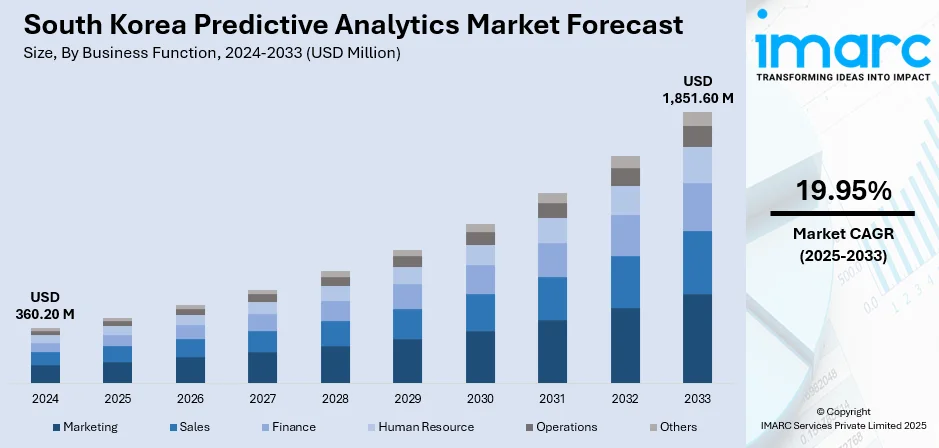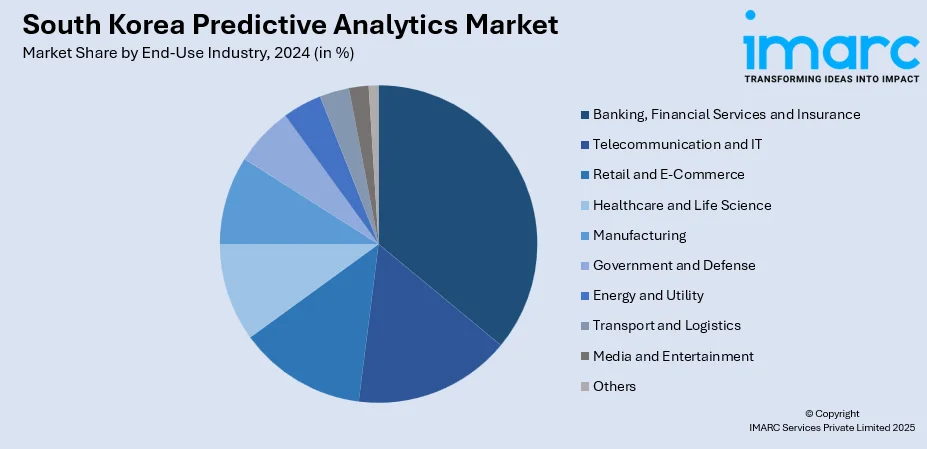
South Korea Predictive Analytics Market Size, Share, Trends and Forecast by Business Function, Component, Deployment, Organization Size, End-Use Industry, and Region, 2025-2033
South Korea Predictive Analytics Market Overview:
The South Korea predictive analytics market size reached USD 360.20 Million in 2024. Looking forward, IMARC Group expects the market to reach USD 1,851.60 Million by 2033, exhibiting a growth rate (CAGR) of 19.95% during 2025-2033. The market is primarily driven by the increasing adoption of data-driven decision-making across various industries, including retail, healthcare, finance, and manufacturing. The growing emphasis on improving operational efficiency, customer experience, and risk management is also propelling the South Korea predictive analytics market share.
|
Report Attribute
|
Key Statistics
|
|---|---|
|
Base Year
|
2024
|
|
Forecast Years
|
2025-2033
|
|
Historical Years
|
2019-2024
|
| Market Size in 2024 | USD 360.20 Million |
| Market Forecast in 2033 | USD 1,851.60 Million |
| Market Growth Rate 2025-2033 | 19.95% |
South Korea Predictive Analytics Market Trends:
Focus on Healthcare and Risk Management
A major driver of growth in the South Korea predictive analytics market growth is the increasing demand for solutions in the healthcare and financial sectors. In healthcare, predictive models are used for early diagnosis, patient care optimization, and improving clinical outcomes. Predictive analytics is being used by financial organizations to improve accuracy and lower operating costs in risk management, credit scoring, and fraud detection. Predictive analytics is positioned as a game-changing tool in both customized and preventative treatment as South Korea keeps investing in its digital healthcare infrastructure. Similarly, to increase the security and effectiveness of South Korea's strong financial industry and support market expansion, risk management and fraud detection skills are essential. For instance, in February 2025, South Korea's data protection authority suspended new downloads of the Chinese AI app DeepSeek due to non-compliance with privacy regulations. The app's service will resume once improvements are made to meet the country's data protection laws.

To get more information on this market, Request Sample
Growth of Cloud-Based Predictive Analytics Solutions
A major factor in the expanding predictive analytics business in South Korea is cloud computing. By offering real-time insights and removing the need for substantial IT infrastructure, cloud-based solutions give businesses greater flexibility in scaling their predictive analytics capabilities. In sectors like retail, manufacturing, and finance that rely heavily on data, this change is most apparent. Without having to make significant upfront investments, businesses can access sophisticated analytics tools and models by utilizing cloud platforms. This trend is assisting South Korean companies in improving their customer service offerings, increasing operational agility, and streamlining decision-making across a range of applications. For instance, Alibaba Cloud will open its second data center in South Korea by June 2025 to meet the rising demand for AI and cloud services. The new facility, located in Ulsan, will enhance AI capabilities with 60,000 GPUs and support businesses adopting AI, cloud computing, and digital platforms. The investment is part of Alibaba’s global expansion strategy.
South Korea Predictive Analytics Market Segmentation:
IMARC Group provides an analysis of the key trends in each segment of the market, along with forecasts at the country/regional level for 2025-2033. Our report has categorized the market based on business function, component, deployment, organization size, and end-use industry.
Business Function Insights:
- Marketing
- Sales
- Finance
- Human Resource
- Operations
- Others
The report has provided a detailed breakup and analysis of the market based on the business function. This includes marketing, sales, finance, human resource, operations, and others.
Component Insights:
- Solution
- Customer Analytics
- Financial Analytics
- Marketing and Sales Analytics
- Network Analytics
- Risk Analytics
- Supply Chain Analytics
- Web and Social Media Analytics
- Operations Management
- Workforce Management
- Others
- Service
- Deployment/Installation
- Training and Consulting
- Support and Maintenance
A detailed breakup and analysis of the market based on the component have also been provided in the report. This includes solution (customer analytics, financial analytics, marketing and sales analytics, network analytics, risk analytics, supply chain analytics, web and social media analytics, operations management, workforce management, and others) and service (deployment/installation, training and consulting, and support and maintenance).
Deployment Insights:
- Cloud-based
- On-premises
The report has provided a detailed breakup and analysis of the market based on the deployment. This includes cloud-based and on-premises.
Organization Size Insights:
- Small and Medium-sized Enterprises
- Large Enterprises
A detailed breakup and analysis of the market based on the organization size have also been provided in the report. This includes small and medium-sized enterprises and large enterprises.
End-Use Industry Insights:

- Banking, Financial Services and Insurance
- Telecommunication and IT
- Retail and E-Commerce
- Healthcare and Life Science
- Manufacturing
- Government and Defense
- Energy and Utility
- Transport and Logistics
- Media and Entertainment
- Others
The report has provided a detailed breakup and analysis of the market based on the end-use industry. This includes banking, financial services and insurance, telecommunication and IT, retail and E-commerce, healthcare and life science, manufacturing, government and defense, energy and utility, transport and logistics, media and entertainment, and others.
Regional Insights:
- Seoul Capital Area
- Yeongnam (Southeastern Region)
- Honam (Southwestern Region)
- Hoseo (Central Region)
- Others
The report has also provided a comprehensive analysis of all the major regional markets, which include Seoul Capital Area, Yeongnam (Southeastern Region), Honam (Southwestern Region), Hoseo (Central Region), and others.
Competitive Landscape:
The market research report has also provided a comprehensive analysis of the competitive landscape. Competitive analysis such as market structure, key player positioning, top winning strategies, competitive dashboard, and company evaluation quadrant has been covered in the report. Also, detailed profiles of all major companies have been provided.
South Korea Predictive Analytics Market News:
- In June 2025, SK Group and AWS partnered to build South Korea's largest AI data center in Ulsan, with AWS investing $4 Billion. The project will feature 60,000 GPUs and a capacity of 1 GW by 2029. This initiative aims to strengthen SK Telecom’s AI infrastructure and support growing AI applications across various industries.
South Korea Predictive Analytics Market Report Coverage:
| Report Features | Details |
|---|---|
| Base Year of the Analysis | 2024 |
| Historical Period | 2019-2024 |
| Forecast Period | 2025-2033 |
| Units | Million USD |
| Scope of the Report |
Exploration of Historical Trends and Market Outlook, Industry Catalysts and Challenges, Segment-Wise Historical and Future Market Assessment:
|
| Business Functions Covered | Marketing, Sales, Finance, Human Resource, Operations, Others |
| Components Covered |
|
| Deployments Covered | Cloud-based, On-premises |
| Organization Sizes Covered | Small and Medium-sized Enterprises, Large Enterprises |
| End-Use Industries Covered | Banking, Financial Services and Insurance, Telecommunication and IT, Retail and E-Commerce, Healthcare and Life Science, Manufacturing, Government and Defense, Energy and Utility, Transport and Logistics, Media and Entertainment, Others |
| Regions Covered | Seoul Capital Area, Yeongnam (Southeastern Region), Honam (Southwestern Region), Hoseo (Central Region), Others |
| Customization Scope | 10% Free Customization |
| Post-Sale Analyst Support | 10-12 Weeks |
| Delivery Format | PDF and Excel through Email (We can also provide the editable version of the report in PPT/Word format on special request) |
Key Questions Answered in This Report:
- How has the South Korea predictive analytics market performed so far and how will it perform in the coming years?
- What is the breakup of the South Korea predictive analytics market on the basis of business function?
- What is the breakup of the South Korea predictive analytics market on the basis of component?
- What is the breakup of the South Korea predictive analytics market on the basis of deployment?
- What is the breakup of the South Korea predictive analytics market on the basis of organization size?
- What is the breakup of the South Korea predictive analytics market on the basis of end-use industry?
- What is the breakup of the South Korea predictive analytics market on the basis of region?
- What are the various stages in the value chain of the South Korea predictive analytics market?
- What are the key driving factors and challenges in the South Korea predictive analytics market?
- What is the structure of the South Korea predictive analytics market and who are the key players?
- What is the degree of competition in the South Korea predictive analytics market?
Key Benefits for Stakeholders:
- IMARC’s industry report offers a comprehensive quantitative analysis of various Korea market segments, historical and current market trends, market forecasts, and dynamics of the South Korea predictive analytics market from 2019-2033.
- The research report provides the latest information on the market drivers, challenges, and opportunities in the South Korea predictive analytics market.
- Porter's five forces analysis assist stakeholders in assessing the impact of new entrants, competitive rivalry, supplier power, buyer power, and the threat of substitution. It helps stakeholders to analyze the level of competition within the South Korea predictive analytics industry and its attractiveness.
- Competitive landscape allows stakeholders to understand their competitive environment and provides an insight into the current positions of key players in the market.
Need more help?
- Speak to our experienced analysts for insights on the current market scenarios.
- Include additional segments and countries to customize the report as per your requirement.
- Gain an unparalleled competitive advantage in your domain by understanding how to utilize the report and positively impacting your operations and revenue.
- For further assistance, please connect with our analysts.
 Request Customization
Request Customization
 Speak to an Analyst
Speak to an Analyst
 Request Brochure
Request Brochure
 Inquire Before Buying
Inquire Before Buying




.webp)




.webp)












